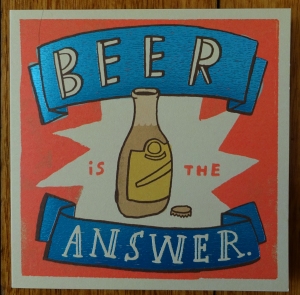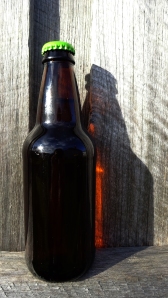Watching the beer ferment was not so exciting. It was still a bit smelly and took up valuable bench space in our kitchen, but eventually I stopped thinking the ‘blooping’ noise was a dripping tap.
The instructions for the Coopers Australian Pale Ale recommends fermenting between 21-27 degrees but the guy in the home brew shop had recommended slightly lower at between 18-20 degrees over a longer period to achieve a better taste. I think he used some other descriptive beer words but to be honest I really only heard ‘better beer’ and decided to give the guy’s advice a go.
The temperature in our kitchen can go from very cold over night to really warm during the day, especially when I’m cooking with the oven, so ensuring the beer remained at a consistent temperature meant keeping an eye on the thermometer and adjusting the position of heat belt wrapped around the barrel, and usually turning it off during the day and back on at night.
Eventually the blooping slowed right down and Dave suggested we bottle at about 10 days. I realised I hadn’t finished buying up the really swish Japanese beer bottles I’d started to collect and when we went to get the rest they were out of stock. In a panic we then bought a dozen of similar looking bottles and invited the other house up for dinner to empty them with us. They didn’t hesitate to help the other team out here. I’m a bit disappointed in the new bottles as they don’t have the same clean lines as the original style did and look a bit more like your average stubbie.

After the rush of getting the bottles ready (read drunk), Dave then advised the beer was still blooping a bit much and it would be better to wait as this process would be more important than time in the bottle. In the end we waited nearly another week, so the beer had been in the barrel for around the 17 day mark, but 16 from when the yeast went in.
The equipment we used for bottling included the bottles, bottle caps, Coopers DIY Beer carbonation drops, oven, chopping board, the barrel of beer, bottle filler (long plastic tube that fixes onto the barrel’s stop tap) and a bottle capper.
Dave showed me how to set up a very efficient layout for bottling process. Bottles in the oven for sterilising, up onto a chopping board sitting on the cooktop ready for filling, drop in the carbonation drops (1 for the stubbies, 2 for the long necks), hold the bottle so the spring loaded end of the bottle filler touches the base of the bottle and voila, the beer spills out. Fill the bottle to the brim then pull the bottle away from the filler to release the pressure. This leaves a nice air gap in the bottle. The filling was probably the trickiest part, but after a few goes I got into a rhythm that didn’t involve most of the bottle being filled with foam.
Dave was a bit tired and hungry so gave me really short answers when I butted in to ask questions like, ‘is that just sugar’ and ‘what’s the plastic tube called’. I had one of those grass is greener moments and thought how Glenn would give me a longer explanation, but then imagined Lex staring at Glenn secretly wishing he’d give her a much shorter answer. So I just read the back of the drops packet (sugar and glucose to be exact) and googled the correct name for the tube (aka bottle filler).
I’d forgotten I hadn’t decided on which colour bottle caps to use yet and knowing that Lex had black ones, I went with the green instead. And gold for my lucky 13 bottle – but I can’t reveal too much about him yet!
I hear that Glenn is very excited about how excellent their beer tastes already, but I have to admit that even though I only licked a drip off from the back of my hand from some overflow, I’m pretty sure mine just tastes like beer. Dave did reassure me that I do know how to pick the taste of bad home brew, like the dodgy Pilsner he did once…

Read how I began the beer-off process in ‘Beer from a can‘.
